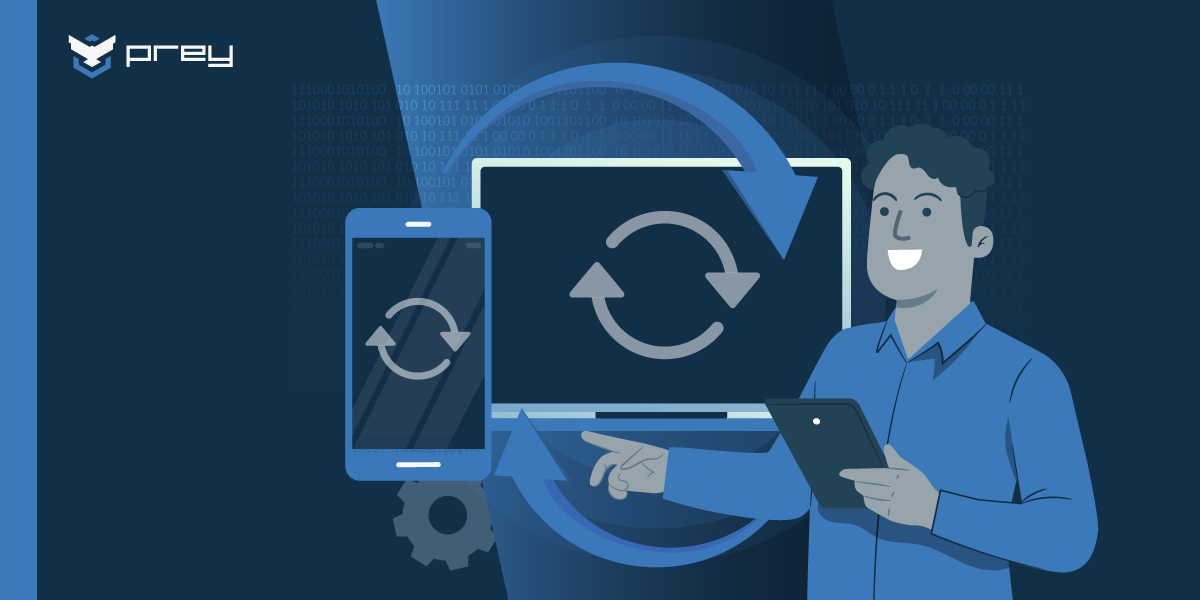As the digitization of education continues to permeate modern learning environments, mobile devices have become an essential part of the educational infrastructure.
Education institutions are now leveraging technology by offering lending programs to provide students with tablets, laptops, Chromebooks, and other technology required for their coursework. Without a well-structured plan, the distribution of these devices can quickly become a cumbersome process, especially for understaffed -and underbudgeted- IT departments dealing with a large volume of loans.
In addition, as these devices store sensitive student information and serve as portals to digital classrooms, they present potential targets for cybersecurity threats. Effective asset management is crucial in managing devices and other school district assets, ensuring accurate inventory tracking, time savings, compliance, security, and financial stewardship.
Overlooking these aspects can lead to significant challenges, making the efficient execution of the lending program an intricate task for educational institutions. But luckily, implementing an efficient and reliable lending program can help educational organizations overcome these challenges.
Best Practices for Device Distribution
A successful device distribution starts with comprehensive pre-deployment planning. This includes conducting in-depth research and engaging with the entire school community - students, parents, and faculty - to understand the unique needs and requirements of the institution's 1:1 program. With this information, schools can create a more tailored device distribution strategy that caters to everyone involved.
Selecting the right devices for a school district is a crucial aspect of this planning phase. Each device should not only have the necessary capabilities to support the educational programs, but also the durability to withstand daily student use, all while fitting into the school's budget. Therefore, device selection should be a carefully considered process, involving various stakeholders from the school district.
Additionally, effective device lifecycle management is essential for managing the entire lifespan of technology devices used in K-12 education. This includes purchasing, distribution, tracking, auditing, supporting, and collecting devices, addressing challenges such as repair, compliance, and future budget forecasting.
Pre-deployment: The things that matter
After gathering information and understanding needs, a detailed plan should be created in collaboration with all departments involved. This plan should outline the strategies for device management, IT support, and assistance submission, including:
Before deploying devices to students, it's essential to conduct a thorough inventory check of existing devices in the fleet. Accurate records provide a clear starting point for device distribution and are instrumental in managing resources efficiently. By identifying the devices already on hand, schools can avoid unnecessary purchases and ensure that resources are allocated appropriately, saving both time and money.
Here are some things to consider:
- Budget allocation: A clear understanding of the funds available will guide the entire process, from the number and type of devices purchased to the software they're equipped with and the maintenance plans they're covered under.
- Number of devices to be serviced or retired: Devices that are being reused from previous years should be checked out to see if they are fit to be used again. If their hardware is up to snuff, then it’s worth setting the device to its factory settings to be re-used. But if the device is beyond repair, or if it has suffered damage that would impair its functionality, then it’d be better to retire it.
- Number of devices to be lent out: This should be determined based on student and faculty needs, the device-to-student ratio policy of the school, and the budget.
- Policies regarding off-campus use of devices: It is essential to have clear rules about whether and when devices can be taken off campus, and more importantly, what can the students do with their devices. This not only protects the device but also helps in managing internet safety and device usage.
- Lending program policies: These policies should guide on device usage, the responsibilities of the students, teachers, and parents, and consequences for policy violations.
- Privacy policies: With the increasing usage of digital platforms, protecting student data is paramount. Privacy policies should address how data will be collected, used, stored, and shared, and also address which tools will be used to handle the devices themselves as they should comply with regulations like FERPA.
- Incident policies: These policies should cover various incidents like loss, theft, and ransomware attacks, and guide how each incident should be reported and resolved.
- Procedures for technical support: A clear process for reporting issues and receiving technical support helps to reduce downtime and frustration for students and teachers alike.
- Protocols for reporting lost or stolen devices, and security incidents: Prompt reporting can help in quick resolution, minimize the impact of the incident, and prevent similar occurrences in the future.

Gradual Rollout
Starting the device distribution with a limited group of teachers enables the school to test the waters before a full-scale rollout. This initial wave can face several challenges, including software compatibility issues, hardware malfunctions, network connectivity problems, or user errors. However, these issues can be addressed promptly and without overwhelming the IT team due to the limited scale.
In the modern classroom, where teachers manage multiple tasks, efficient device management solutions are crucial to avoid losing valuable class time.
After resolving initial challenges, the program can gradually expand to full grade-level device rollouts before eventually becoming school-wide. This phased approach allows effective management of increased workload and encourages peer training, enabling staff to learn from each other's experiences.
The gradual rollout has numerous benefits:
- It provides a buffer for unforeseen issues that might arise when new devices are introduced, allowing for problems to be identified and resolved on a smaller scale.
- It helps to manage the workload effectively, preventing the IT department from becoming overwhelmed with support requests.
- Teachers in the initial rollout group can serve as "tech ambassadors," providing peer-to-peer support and training. This not only lessens the load on the IT team but also fosters a collaborative learning environment.
- It builds confidence among staff and students. Seeing the successful implementation in the initial phase can help reduce resistance and increase excitement about the new devices in later stages.
- It allows for real-time feedback and necessary adjustments in the rollout plan before a broader implementation, ensuring the process is continually refined and improved.

The things that matter
Planning for a gradual rollout requires careful consideration of multiple aspects to ensure a smooth and efficient device distribution. As we already mentioned, knowing who, where, and when will ease the process of lending the devices not only to the people lending them but also to the people receiving them.
Here are some key elements to consider:
- Location: A designated location for device distribution helps maintain order and efficiency. It's crucial to select a location that's accessible, has enough space to store the devices securely, and can accommodate the traffic of students or families coming in to pick up the devices.
- Schedules: Scheduling is essential to avoid overburdening staff and to ensure that distribution is spread out effectively. It also helps students and their families prepare and plan for the device pick-up, making the process more convenient for them
- Delivery process: The delivery process should be streamlined to avoid confusion and facilitate easy tracking. This may include steps like unboxing, labeling, testing, and charging devices before delivery. A well-structured process can ensure devices are ready for use as soon as they reach the students.
- Who will physically deliver the device: Identifying responsible personnel for device distribution is vital to ensure accountability. This not only helps in maintaining order during distribution but also provides a point of contact for any queries or concerns related to the devices.
School device management and pre-deployment procedures
Clear and decisive communication is a cornerstone of successful pre-deployment planning. Informing all relevant stakeholders - from educators and administrators to students and parents - about the planned deployment helps ensure that everyone is on the same page.
This unified understanding can significantly smooth the distribution event, mitigating potential confusion or misunderstanding. By establishing open lines of communication, schools can foster a sense of collaboration and shared responsibility, making the transition to digital learning more seamless and less stressful.
Effective device lifecycle management is crucial in managing the entire lifespan of technology devices used in K-12 education. This includes purchasing, distribution, tracking, auditing, supporting, and collecting devices. Addressing challenges such as device distribution, monitoring, repair, collection, reporting, compliance, and funding is essential. Utilizing help desk and asset management systems can streamline the process and forecast future budget purchases.
Loan asset managers, such as the one provided by Prey, can significantly aid in pre-deployment procedures, device maintenance, and end-of-year device collection. It provides a centralized platform to manage all device-related tasks, from tracking device location to managing device inventory and triggering remote actions like data wiping in case of device loss or theft.
By automating these tasks, it reduces the workload on the IT team, minimizes human errors, and increases the efficiency of device management, making it a valuable tool for educational organizations. A Device Manager enhances the overall experience by streamlining the process, ensuring device security, and facilitating effective management of device loans.
Here are some essential security policies:
- Installation of Necessary Student Applications: By ensuring that all required applications and educational software are pre-installed on devices, the device distribution process becomes more seamless and reduces setup time for students, enabling them to dive into their learning activities right away.
- Access Configuration: Implementing appropriate access controls and user authentication measures is crucial to safeguard sensitive data stored on the devices. This ensures that only authorized individuals can access the devices, protecting against unauthorized usage and potential data breaches.
- Security Tools for Incidents: Deploying robust security tools, such as antivirus software and device tracking solutions, adds an extra layer of protection to the devices. These tools help mitigate potential security incidents, detect malware or viruses, and enable quick response in the event of a device theft or breach.
- Loan Manager: Utilizing a loan manager system streamlines the management of device loans within educational organizations. A comprehensive loan manager, like Prey's built-in Loan Manager, offers features such as loan tracking, monitoring, and reporting, ensuring accountability and efficient allocation of devices. This simplifies the process of loaning devices to students and tracking their usage, making it easier for educational organizations to manage their device inventory effectively.
Monitoring
Conducting regular audits of school devices throughout the year is essential to maintain device security and optimal performance. By conducting audits and keeping an eye on school devices, educational organizations can identify any security vulnerabilities and ensure compliance with usage policies. This proactive approach helps create a safe and efficient learning environment for students and allows for timely maintenance and support, and can be done through software that tracks the device’s status or hardware changes remotely.
Moreover, conducting regular audits throughout the year to verify device ownership and condition can significantly streamline the IT support process. These audits can detect potential issues, such as damage or loss, early on and address them promptly, reducing disruption to learning. Regular checks also ensure that devices are maintained properly and are being used responsibly, encouraging students to take better care of the devices entrusted to them.
Benefits of setting up regular audits include:
- Accuracy of device records: Regular audits ensure device inventory is kept up-to-date, enhancing accountability.
- Early detection of issues: Regular audits can catch problems early. Malfunctions in hardware and improper device usage can indicate that something is off and worth investigating. Being proactive can potentially save time and money on repairs.
- Encourages responsible use: When students know that their device will be checked, they are likely to take better care of it.
- Reduces IT support needs: With regular maintenance and checks, there's less likelihood of major, time-consuming repairs, freeing up IT resources.
Incident response and security
The advent of mobility programs in educational institutions has made device-tracking tools more critical than ever. An efficient tracking system enables rapid identification of lost or stolen devices, significantly minimizing the potential loss and disruption to the educational process. Such systems not only help in tracing devices but also serve as a deterrent against device misuse. The ability to pinpoint the location of devices in real-time allows for an immediate response, making it easier to recover misplaced or stolen assets.
In addition to implementing device tracking and geofencing zones, a comprehensive incident response plan should play a pivotal role in managing device-related issues or security breaches. This plan prepares the institution to respond swiftly and effectively when a security incident occurs, mitigating potential harm. It outlines the roles, responsibilities, and procedures to follow in the event of a security breach, ensuring that the response is coordinated and decisive.
What are the benefits of implementing an incident response plan in schools?
- Rapid Response: Having a plan in place ensures quick reaction to security incidents, minimizing potential damage.
- Reduces Impact: A well-defined response can significantly reduce the overall impact of an incident, minimizing disruption to educational activities.
- Fosters Confidence: A robust response plan can boost confidence in the institution's security measures among students, parents, and staff.
- Compliance: A comprehensive plan can help institutions remain compliant with data privacy regulations and standards.

Hunt no more: Recover your devices with Prey
Prey offers a range of features that assist in the effective management and protection of devices, particularly in the case of lost or stolen incidents. Upon detecting a device as missing or a hardware change, Prey enables the user to send missing reports, remotely wipe data, lock the device, and even trigger an alarm.
- Tracking Persistence: Prey continuously monitors and reports the location of lost or stolen devices, ensuring a real-time tracking system is in place even when devices are not within immediate reach.
- Missing Report: Prey can issue a missing report that regularly updates the device's location and status, providing essential information for law enforcement.
- Remote Wipe: Prey has the capability to wipe devices remotely, a crucial feature to protect sensitive data from unauthorized access in case of loss or theft.
- Device Lock: Prey can lock lost or stolen devices remotely, making it impossible for unauthorized users to gain access and compromise the data within.
- Alarm Activation: Prey can activate a loud, unsilenceable alarm on the lost device to aid in its physical location, a feature especially useful when the device is thought to be nearby.
- Hardware Change Notifications: In case of hardware changes, Prey sends notifications. This ensures you are always aware of any potential security breaches or attempts at bypassing the tracking system.
While some of these features, such as the missing report and tracking persistence, may conflict with FERPA regulations, they can be permanently turned off. This allows School institutions to use only the necessary features as and when needed.
Online safety and cybersecurity awareness
When students and staff are equipped with knowledge about safe internet use and cybersecurity best practices, they are more likely to avoid potential security risks. They understand how to identify and avoid phishing scams, use secure passwords, apply appropriate privacy settings, and detect suspicious activity. By promoting digital literacy, schools can help their community to participate in the digital world with confidence and caution, effectively reducing the likelihood of accidental data exposure or misuse.
Regular cybersecurity awareness training is another vital component of online safety. By educating students and staff about potential cyber threats, the institution can dramatically reduce the likelihood of data breaches. This training can cover a variety of topics, including the basics of information security, email, and internet best practices, and how to report potential security threats.
What are the beneifts of cybersecurity awareness for schools?
- Enhanced understanding of potential threats: Through regular training, users can stay updated about the latest threats in the cyber landscape and the best ways to counteract them, thereby improving the overall security posture of the institution.
- Improved ability to recognize and respond to cybersecurity incidents: By knowing what to look for, users can more easily spot potential issues and respond appropriately, such as by alerting the IT team or changing their passwords.
- Greater awareness of individual responsibilities for device and data security: By emphasizing the role each person plays in maintaining cybersecurity, training encourages responsible behavior, such as avoiding the download of suspicious attachments or the use of unauthorized software.
- Development of a culture of cybersecurity in the educational institution: When everyone understands and values cybersecurity, it becomes a part of the school culture, enhancing the resilience of the institution against cyber threats over time.
Dominating device distribution with effective strategies
A successful school-year device distribution requires careful planning, a thorough understanding of the school community's needs, and the selection of the right devices. It's equally important to carry out a gradual rollout, allowing for initial troubleshooting and adjustment before full-scale implementation. Moreover, effective device tracking and strong cybersecurity measures are not just important; they're essential. They ensure the safety and integrity of student data, maintaining a secure learning environment.
Through a combination of these best practices, educational institutions can efficiently manage the challenges of device distribution, thereby enhancing their ability to provide a robust and secure digital learning experience. These practices not only help in managing the immediate task at hand but also pave the way for continued growth in the future of education technology.
Additionally, asset management plays a crucial role in managing devices and other school district assets. Implementing a dedicated asset management system ensures accurate inventory tracking, time savings, compliance, security, financial stewardship, and integration with existing systems.






